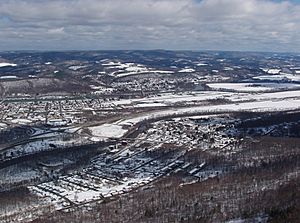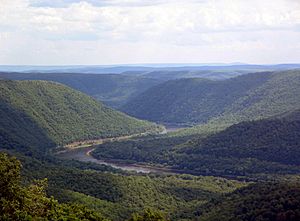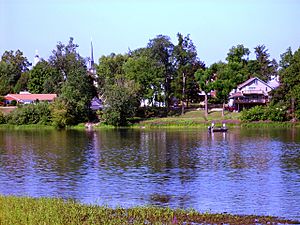West Branch Susquehanna Valley facts for kids

The West Branch Susquehanna Valley is a low-lying area in central Pennsylvania, United States. It's part of the Ridge-and-Valley Appalachians region. This valley drains water into the West Branch Susquehanna River. It's located southeast of the Allegheny Front, northeast of the Bald Eagle Valley, southwest of the Wyoming Valley, and north of a water gap between Shamokin Mountain and Montour Ridge.
The river enters the valley from a deep gorge above Lock Haven. Then it turns east into a wide, flat area called a flood plain. Here, it meets the Bald Eagle Creek after passing Lock Haven. This flood plain is at the base of the Bald Eagle Mountain ridge. It has large, fertile farm fields around the river's bends and islands. Higher up, the valley has small hills below the plateau. Further east, the river is joined by Pine Creek, which also comes from a deep gorge known as Pine Creek Gorge (or the Grand Canyon of Pennsylvania). East of Williamsport, the Bald Eagle ridge ends. The river then turns south, and the valley opens up, following the river to a water gap near Lewisburg.
In Clinton and Lycoming Counties, the valley is northeast of the Bald Eagle Valley. It stretches from Lock Haven to Williamsport.
Contents
History of the Valley
The lands along the West Branch Susquehanna River were very important for Native Americans. They used these areas for hunting and farming. Later, during Pennsylvania's big lumbering time, the largest log drive happened on this river. A log drive is when many cut trees are floated down a river. The West Branch Susquehanna River's Canal Division also changed the area. It connected towns and villages, helping businesses grow. Finally, railroads further linked communities and trade within the valley.
Madame Montour's Village
Madame Montour's village, called Otstonwakin or Ostuagy, was a very important place. It was located at the mouth of Loyalsock Creek where it meets the West Branch Susquehanna River. In the 1740s, Moravian missionaries often stopped here. They were traveling to spread their beliefs across Pennsylvania. For example, Count Zinzendorf visited Ostuagy in 1742. He was guided by Conrad Weiser and had permission from Shikellamy.
Madame Montour was known to be a friend of the British. She welcomed the white settlers who started moving into the West Branch Susquehanna River Valley. She also had a lot of influence with different Native American tribes. These tribes were feeling pressure from the growing number of colonists. Madame Montour stayed loyal to the British, even though the French tried to get her to join their side. This was quite remarkable because the British government sometimes took a year to pay her for her help.
Early People of the Valley
The first people known to live in the West Branch Susquehanna River valley were the Susquehannocks. They spoke an Iroquoian language. Their name meant "people of the muddy river" in Algonquian. By the early 1700s, many of them had died from diseases or wars. Others had moved away or joined other tribes. After them, the lands were mainly used by the Munsee group of the Lenape (also called Delaware). These lands were generally controlled by the Five (later Six) Nations of the Iroquois.
The British bought land from the Iroquois in the Treaty of Fort Stanwix in 1768. This opened up what is now Lycoming County for settlement. However, the exact border, called the Line of Property (or Purchase Line), was debated. This line was supposed to divide colonial and Native American lands. The colonists said "Tiadaghton Creek" was Pine Creek. But the Iroquois and other tribes said it was Lycoming Creek. So, the area between Pine and Lycoming Creeks was disputed. Settlers who lived there illegally created their own government system. They were known as the "Fair Play Men". They even declared their independence from Britain on July 4, 1776.

During the American Revolutionary War, settlements in the Susquehanna valley were attacked. These attacks came from British supporters (Loyalists) and Native Americans allied with the British. After a big battle and massacre in the Wyoming Valley in 1778, a "Big Runaway" happened. This caused settlers all over the West Branch Susquehanna valley to flee. They were afraid of attacks. People left their homes and fields. They drove their animals and floated their belongings on rafts down the river. They went east to Muncy and then south to Sunbury. The attackers burned the abandoned properties. Some settlers returned later, but had to flee again in 1779 during the "Little Runaway". Sullivan's Expedition helped make the area safer. This encouraged people to resettle after the war.
The Fair Play Men
The Fair Play Men were settlers who lived illegally on land claimed by Native Americans. They created their own system of self-rule from 1773 to 1785. This happened in the West Branch Susquehanna River valley of Pennsylvania. Since they were on Native American land, they couldn't use the Pennsylvania colonial government for help. So, they set up the Fair Play System. They elected three commissioners who made decisions about land claims and other issues for the group. In a surprising event, the Fair Play Men wrote their own declaration of independence from Britain. They did this on July 4, 1776, under the "Tiadaghton Elm" tree near Pine Creek.
Fort Antes
Fort Antes was a stockade built around the home of Colonel John Henry Antes. It was built around 1778 during the American Revolution in Pennsylvania. Colonel Antes, a member of the Pennsylvania militia, directed its construction. The fort was on the east side of Antes Creek. It overlooked the West Branch Susquehanna River from a high flat area in Nippenose Township. This is south of modern-day Jersey Shore in western Lycoming County. The local militia held the fort for a short time. But they were ordered to leave Fort Antes during the Big Runaway by Colonel Samuel Hunter. Even though it was left empty and British forces tried to burn it, Fort Antes was one of only two buildings in the valley that survived the Big Runaway.
The Susquehanna Boom
The Susquehanna Boom was a special system in the West Branch Susquehanna River. It was made of connected wooden structures called "cribs." These cribs were designed to hold timber in the river. This allowed the logs to be processed at nearly 60 sawmills. These mills were located along the West Branch Susquehanna River between Lycoming and Loyalsock Creeks in Lycoming County. The boom was built in 1846 under James H. Perkins.
A boom is like a long chain of floating logs or timbers. It stretches across a river to stop or catch things floating by. The Susquehanna Boom was seven miles long. It went from Duboistown upstream to Linden. The boom was built using 352 man-made islands called "cribs." These cribs were made of local stone and sunken timber. They stretched diagonally across the river. They started on the south side near Duboistown and ended on the north side near Linden. Each crib was 22 feet high.
At the upper end, a "sheer boom" opened and closed the main boom. This sheer boom was 1,000 feet long and was moved by a hand-powered windlass. It gathered logs into the main boom, which could hold up to 300 million board feet of logs. At the lower end of the boom, the logs were sorted. Mills in Williamsport, South Williamsport, and Duboistown each had their own special mark burned into the logs. Workers at the end of the boom sorted the logs by their mark. Then, they floated them into the correct holding pond along the riverbank.
During the peak of the lumber industry in Lycoming County (1861–1891), the mills produced 5.5 billion board feet of lumber. Williamsport became one of the richest cities in Pennsylvania and the United States. Men like James H. Perkins, Peter Herdic, and Mahlon Fisher became millionaires. However, many of the workers who actually worked in the river struggled to live on the low wages paid by the lumber barons.
Main Towns in the Valley
Here are the main towns along the West Branch Susquehanna River, listed from west to east (downstream):




